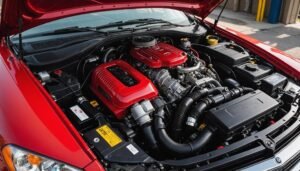When you think about NASCAR, speed is often the first thing that comes to mind. These cars can reach speeds that astound even the most seasoned fans. With their powerful V8 engines and aerodynamic designs, they’re built for performance on oval tracks. But have you ever wondered what truly drives these remarkable speeds? There’s much more behind the numbers than you might expect. Let’s explore the fascinating mechanics of NASCAR speed.
Key Takeaways
- NASCAR vehicles can exceed speeds of 200 mph, particularly on superspeedway tracks like Talladega and Daytona.
- Bill Elliott holds the record for the fastest speed in NASCAR history, reaching 212.809 mph in 1987.
- The average race speed during a NASCAR event typically hovers around 190 mph.
- Engine power, aerodynamics, and tire grip significantly influence how fast NASCAR cars can go.
- Driver skill plays a crucial role in navigating high speeds and maintaining vehicle stability on the track.
The Basics of NASCAR Speed

When you watch a NASCAR race, you can’t help but be amazed by the sheer speed of the cars as they zoom around the track. NASCAR vehicles can reach staggering speeds, often exceeding 200 mph. These high-performance stock cars are specially designed for maximum aerodynamics, featuring streamlined shapes to minimize air resistance. Each car is outfitted with a powerful V8 engine that produces around 750 horsepower, enabling rapid acceleration.
Race teams also meticulously tune gear ratios to enhance speed on various track types. This optimization allows drivers to maintain high velocities through curves and straightaway stretches. Besides mechanical prowess, driver skill plays an essential role in harnessing that speed, as they must navigate tight turns while keeping their car stable. Ultimately, this combination of engineering and expertise sets NASCAR apart, highlighting a thrilling display of speed and control that captivates fans worldwide.
Factors Influencing Speed

While a NASCAR car’s top speed is impressive, several key factors influence how fast it can really go on the track. First, aerodynamics play an essential role. The car’s design minimizes air resistance, allowing it to slice through the wind more efficiently. Next, traction is critical; the tires’ grip on the asphalt can either propel you forward or leave you spinning. Engine power is another major factor—more horsepower often translates to higher speeds, but this must be balanced with weight. Additionally, track conditions markedly affect performance. A hot, slick surface can reduce grip, while a cooler, rougher track may enhance it. Finally, driving skill is important; knowing when to throttle and how to corner can make all the difference in achieving ideal speed. By understanding these dynamics, drivers can better strategize their approach to maximize their velocity during races.
Record-Breaking Speeds in NASCAR History

In NASCAR history, a few standout moments have showcased speeds that push the limits of engineering and driver skill, enthralling fans and driving the sport forward. The legendary Bill Elliott set a record speed of 212.809 mph during a qualifying run at Talladega Superspeedway in 1987, a mark that remains unbeaten. Fast-forward to 1997, and you’d see the famous “Intimidator,Dale Earnhardt, clocking in at 192.5 mph during a race, solidifying his legacy. These records aren’t just numbers; they’re the pinnacle of performance, showing how drivers and teams relentlessly aim for more. The 200 mph barrier was broken several times, introducing thrilling speeds that fans still talk about. As you watch today’s races, remember these moments, where history was made and the thrill of NASCAR surged forward, all thanks to speed-driven excellence and fierce competition.
The Role of Technology and Engineering
As NASCAR races evolve, technology and engineering play an essential role in achieving the incredible speeds we see on the track. From advanced aerodynamics to powerhouse engines, each component is meticulously designed to enhance performance and safety.
| Technology | Impact on Speed | Example |
|---|---|---|
| Aerodynamic Design | Reduces drag | Rear spoilers, diffusers |
| Engine Efficiency | Increases horsepower | Fuel injection systems |
| Tire Composition | Enhances grip | Softer compounds |
The integration of these innovations guarantees that cars can handle high speeds while maintaining stability. You’ll often hear about wind tunnel testing, which helps engineers refine shapes to reduce air resistance. On top of that, advanced telemetry systems provide real-time data, allowing teams to fine-tune setups during races. All these technical advancements combine to push NASCAR vehicles beyond traditional limits, showcasing a blend of science and speed.
Comparisons to Other Motorsports
When you compare NASCAR to other motorsports, you’ll find striking differences in speed, design, and race formats. NASCAR cars are built for oval tracks, allowing them to reach average speeds of around 190 mph during races, which sets them apart from other racing series that often feature road courses and diverse terrains.
Here are a few key comparisons:
- Formula 1: These cars can hit speeds over 230 mph but emphasize cornering and braking rather than outright speed.
- IndyCar: Similar to F1, but with an emphasis on both oval and road racing, with speeds also reaching around 230 mph.
- Rally Racing: Focuses on off-road conditions and varied terrains, with much lower speeds but demanding skill and precision.
NASCAR promotes endurance and strategy over raw speed, creating a unique racing experience for fans.
Frequently Asked Questions
What Type of Fuel Do NASCAR Cars Use?
NASCAR cars use a specially formulated fuel called Sunoco Green E15, which consists of 15% ethanol and 85% gasoline. This blend helps improve performance while being more environmentally friendly than traditional fuels. The high-octane nature of E15 guarantees that your engine runs efficiently, providing the power and reliability needed on the track. It’s designed to meet the unique demands of racing, assuring you get maximum speed and performance during every lap.
How Do Tire Choices Impact Lap Times?
Tire choices considerably impact lap times by influencing grip, durability, and overall performance. When you select softer tires, you gain better traction, which can lead to faster lap times, especially in corners. However, these tires wear out quicker. On the other hand, harder tires may last longer but offer less grip, slowing you down. Balancing between tire wear and speed is essential to optimize your performance throughout the race. Choose wisely!
What Safety Measures Are in Place for High Speeds?
NASCAR employs several robust safety measures to protect you during high-speed racing. Cars feature reinforced roll cages, energy-absorbing foam, and SAFER barriers on tracks to reduce impact forces. Drivers wear helmets and HANS devices, securing their heads during crashes. The ignition switch includes a kill switch for emergencies, allowing quick shutdown. Finally, in-car communication systems enable drivers to stay in touch with pit crews, ensuring immediate response to any safety concerns.
How Often Are NASCAR Cars Serviced During a Race?
During a race, you might think NASCAR cars get pampered like a celebrity on vacation. In reality, they’re serviced during pit stops, which occur every 30 to 60 laps—or about 30 minutes of racing. Teams quickly change tires, refuel, and tweak mechanical issues, all while you’re chewing popcorn. These stops are essential; a well-timed pit can mean the difference between victory and a totally upset driver. It’s a pit stop balletic spectacle you don’t want to miss!
Are There Weight Restrictions for NASCAR Vehicles?
Yes, there are weight restrictions for NASCAR vehicles. Each car must weigh a minimum of 3,400 pounds, including the driver, after the race. This guarantees a level playing field and emphasizes driver skill rather than just car performance. You’ll also find that teams carefully balance their setups to meet these requirements while maximizing speed and handling. Understanding these restrictions can give you deeper insight into the strategy behind a team’s performance on the track.













